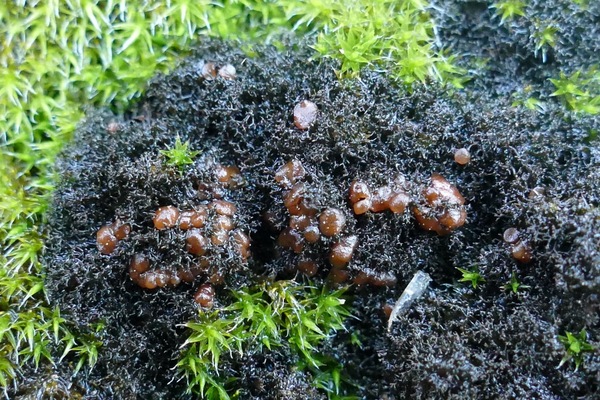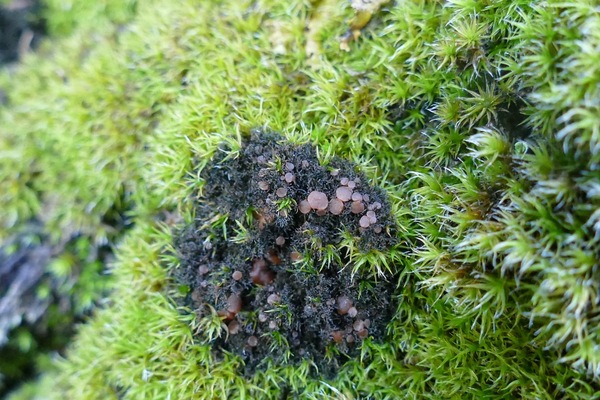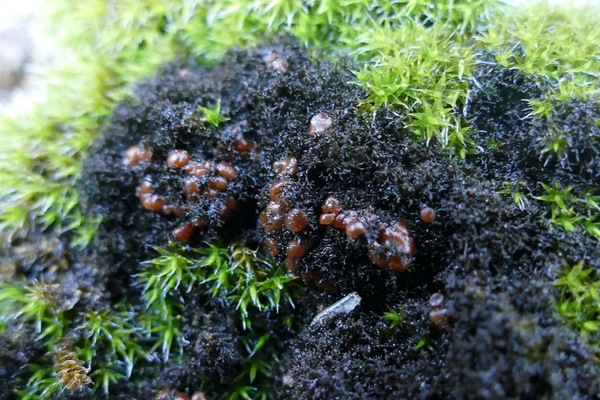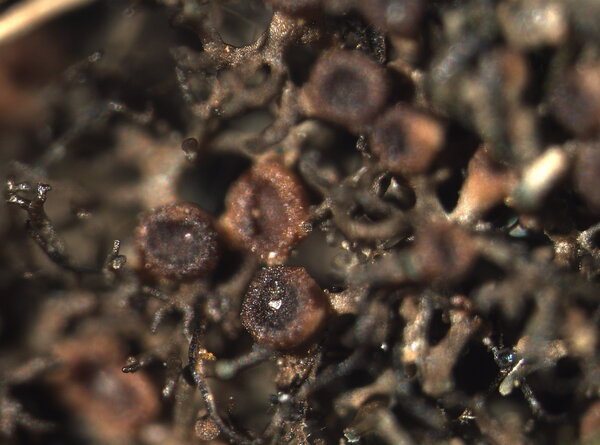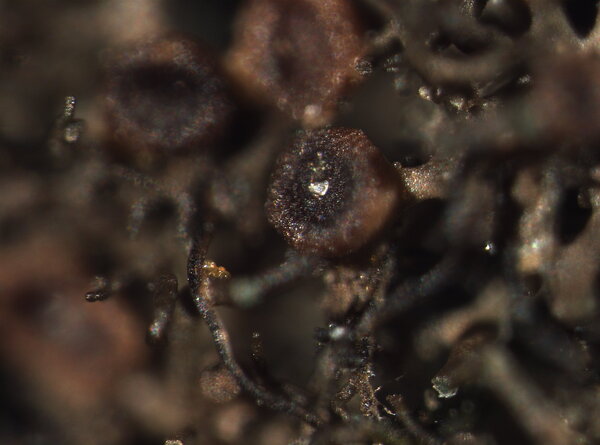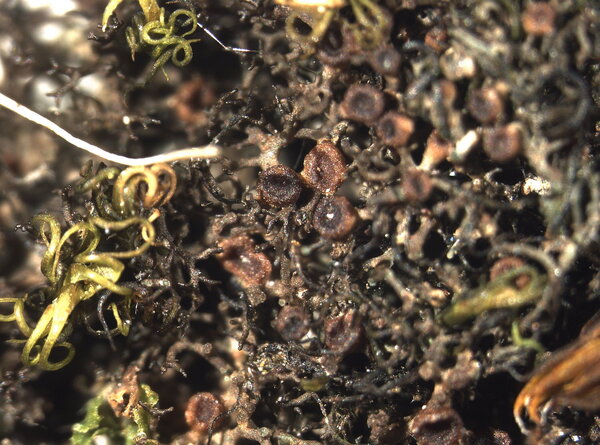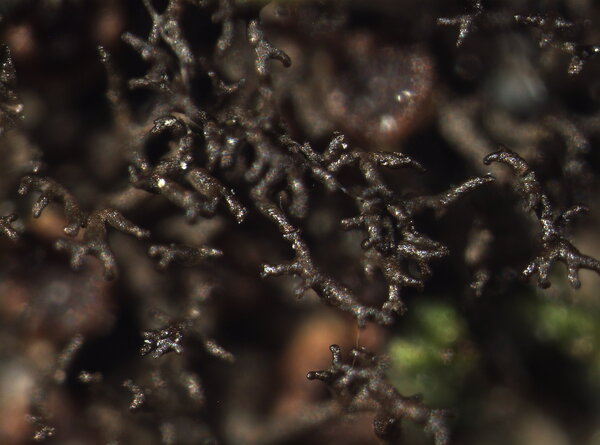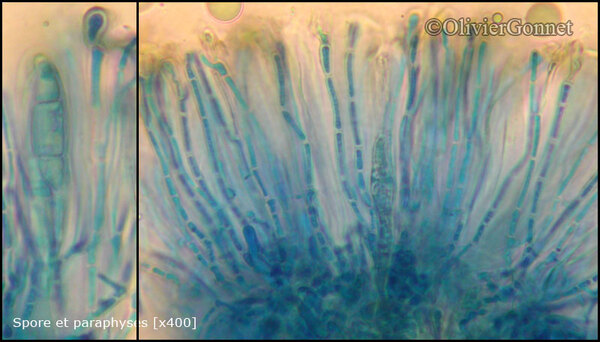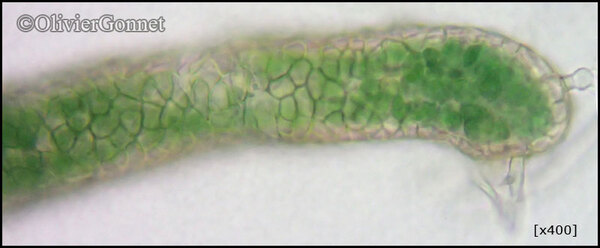Polychidium muscicola (Sw.) Gray
Nat. Arrang. Brit. Pl.: 402, 1821. Basionym: Lichen muscicola Sw. - N. Acta Reg. Soc. Sci. Upsal., 4: 248, 1784.
Synonyms: Collema muscicola (Sw.) Ach.; Homodium muscicola (Sw.) Nyl.; Leptogium muscicola (Sw.) Fr.; Polychidium kalkuense Räsänen
Distribution: N - Frl (Tretiach & Hafellner 2000), TAA (Nascimbene & al. 2022), Lomb (Gheza 2019), Piem (Isocrono & al. 2004), Emil (Fariselli & al. 2020), Lig. C - Sar. S - Camp (Aprile & al. 2003b), Cal (Puntillo 1996), Si (Grillo 1998, Grillo & Caniglia 2004).
Description: Thallus small fruticose, filamentous, brown-black, glossy at least at the tip of young branches, forming loosely attached, up to 1.5 cm tall and up to 3 cm wide small cushions. Branches smooth, slender, (30-)60-125(-200) µm thick, narrower toward apices, divergently and dichotomously or (more rarely) palmately divided. Cortex of 1-3 layers of polygonal cells; central part of thallus of loosely interwoven hyphae in young branches to almost paraplectenchymatous in old ones. Apothecia lateral on the branches, sessile and strongly constricted at base, up to 1.5(-2) mm across, with a red-brown, concave to flat disc and a thin, smooth proper margin. Epithecium brownish; hymenium colourless, I+ blue; paraphyses simple, distinctly thickened above; hypothecium colourless to pale brown. Asci 8-spored, broadly cylindrical, the apices thickened with internal, amyloid sheets. Ascospores 1-septate, hyaline, sometimes weakly pigmented when old, spindle-shaped or ellipsoid (often within the same apothecium), (15-)18-25(-30) x 4.5-7(-11) µm. Pycnidia dark, not common. Conidia hyaline, bacilliform, 1.5-3.5 x c. 1 µm. Photobiont cyanobacterial (Nostoc, the cells mostly in clusters, rarely in short chains). Spot tests: all negative. Chemistry: without lichen substances.Note: a widespread mild-temperate to southern boreal lichen found on soil and amongst bryophytes over siliceous substrata, more rarely on the basal parts of ancient trees, with a rather wide altitudinal range.
Growth form: Crustose
Substrata: soil, terricolous mosses, and plant debris
Photobiont: cyanobacteria, filamentous (e.g. Nostoc, Scytonema)
Reproductive strategy: mainly sexual
Most common in areas with a humid-warm climate (e.g. most of Tyrrenian Italy)
Commonnes-rarity: (info)
Alpine belt: absent
Subalpine belt: extremely rare
Oromediterranean belt: extremely rare
Montane belt: very rare
Submediterranean belt: extremely rare
Padanian area: absent
Humid submediterranean belt: very rare
Humid mediterranean belt: very rare
Dry mediterranean belt: absent
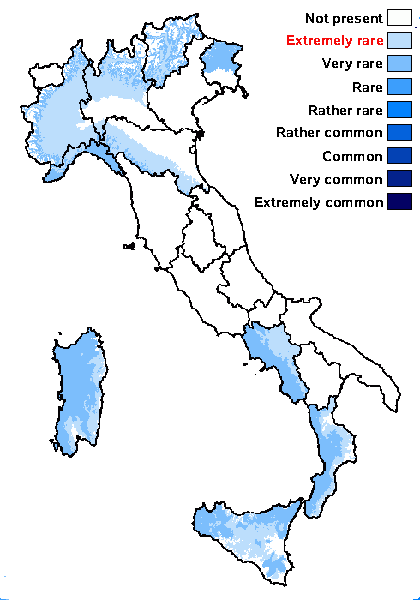
Predictive model
Herbarium samples
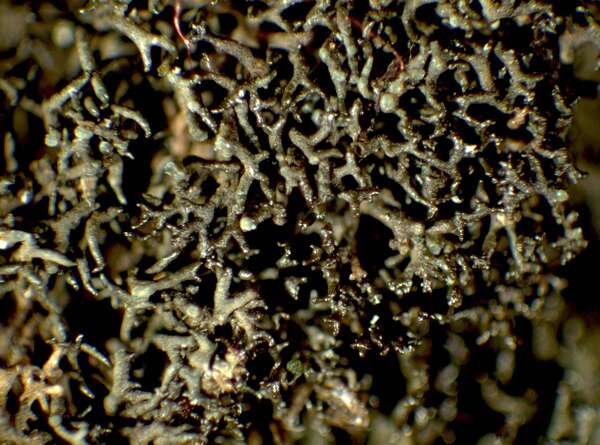

P.L. Nimis; Owner: Department of Life Sciences, University of Trieste
Herbarium: TSB (5166)
2001/11/28
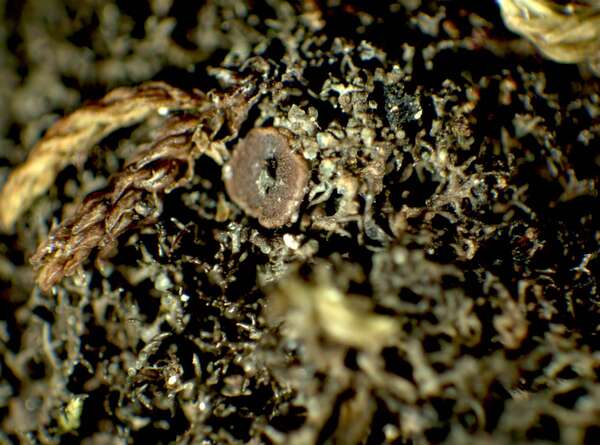

P.L. Nimis; Owner: Department of Life Sciences, University of Trieste
Herbarium: TSB (5166)
2001/11/28
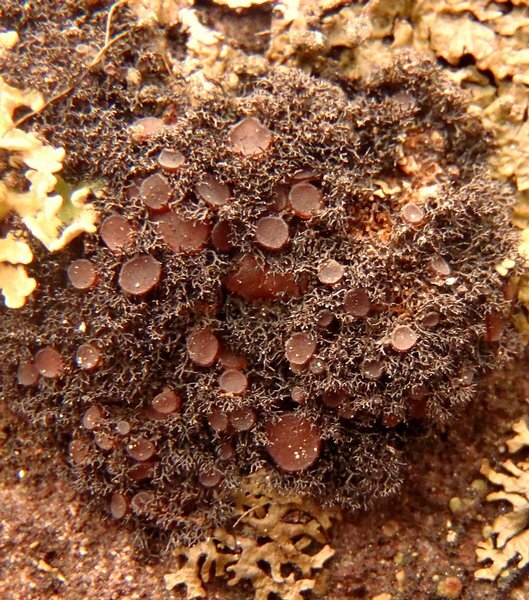

Curtis Randall Björk – CC BY-SA 4.0
British Columbia, Clearwater Valley Date: 2012-04-02 On basalt boulder in conifer-deciduous forest
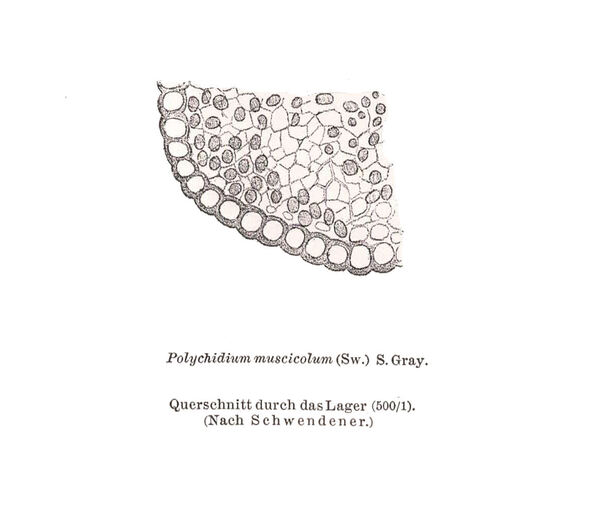
Zahlbruckner A. 1926. Lichenes (Flechten). In: Engler A. (ed.): Die natürlichen Pflanzenfamilien. 2nd ed., vol 8, W. Engelmann, Leipzig, 270 pp.

Courtesy Danièle et Olivier Gonnet - Source: https://www.afl-lichenologie.fr/Photos_AFL/Photos_AFL_P/Text_P_3/Polychidium_muscicola.htm
France, 16/10/2012 - sur Grimmia - Quenza - Corse
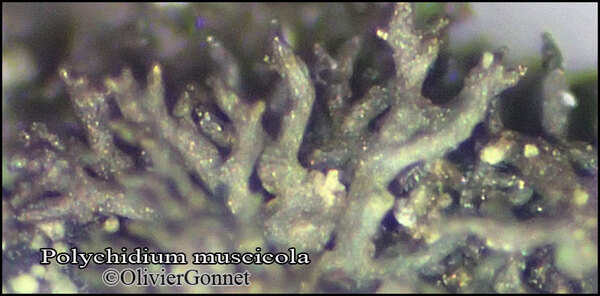
Courtesy Danièle et Olivier Gonnet - Source: https://www.afl-lichenologie.fr/Photos_AFL/Photos_AFL_P/Text_P_3/Polychidium_muscicola.htm
France, 28/12/2014 - session FMBDS - Mont Cenis - Savoie
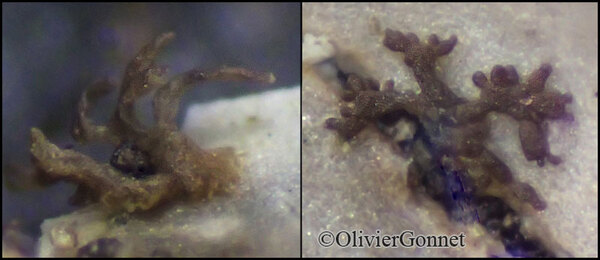
Courtesy Danièle et Olivier Gonnet - Source: https://www.afl-lichenologie.fr/Photos_AFL/Photos_AFL_P/Text_P_3/Polychidium_muscicola.htm
France, 4/11/2013 - Novacelles - sur Peltigera elisabethae établi sur mousse - Puy-de-Dôme
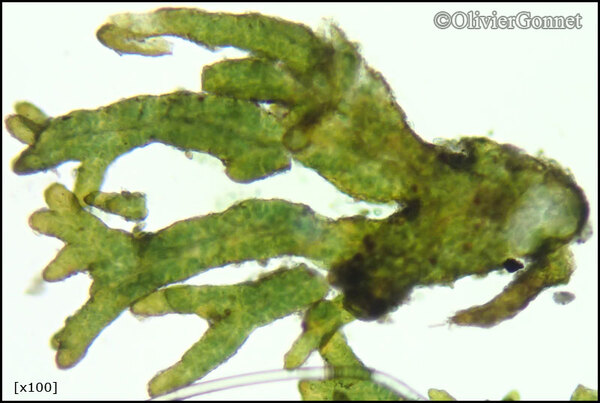
Courtesy Danièle et Olivier Gonnet - Source: https://www.afl-lichenologie.fr/Photos_AFL/Photos_AFL_P/Text_P_3/Polychidium_muscicola.htm
France, 4/11/2013 - Novacelles - sur Peltigera elisabethae établi sur mousse - Puy-de-Dôme
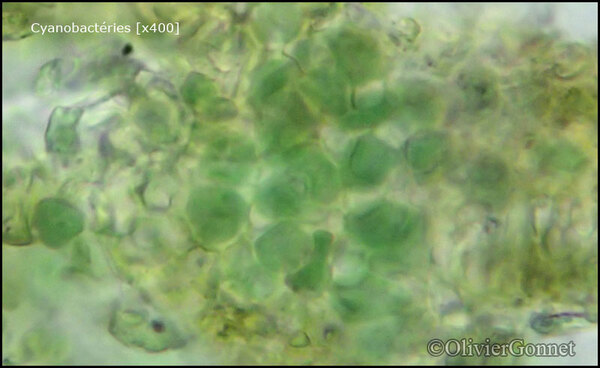
Courtesy Danièle et Olivier Gonnet - Source: https://www.afl-lichenologie.fr/Photos_AFL/Photos_AFL_P/Text_P_3/Polychidium_muscicola.htm
France, 4/11/2013 - Novacelles - sur Peltigera elisabethae établi sur mousse - Puy-de-Dôme

Courtesy Danièle et Olivier Gonnet - Source: https://www.afl-lichenologie.fr/Photos_AFL/Photos_AFL_P/Text_P_3/Polychidium_muscicola.htm
France, 4/11/2013 - Novacelles - sur Peltigera elisabethae établi sur mousse - Puy-de-Dôme
Growth form: Crustose
Substrata: soil, terricolous mosses, and plant debris
Photobiont: cyanobacteria, filamentous (e.g. Nostoc, Scytonema)
Reproductive strategy: mainly sexual
Most common in areas with a humid-warm climate (e.g. most of Tyrrenian Italy)
Commonnes-rarity: (info)
Alpine belt: absent
Subalpine belt: extremely rare
Oromediterranean belt: extremely rare
Montane belt: very rare
Submediterranean belt: extremely rare
Padanian area: absent
Humid submediterranean belt: very rare
Humid mediterranean belt: very rare
Dry mediterranean belt: absent

Predictive model
| Herbarium samples |


P.L. Nimis; Owner: Department of Life Sciences, University of Trieste
Herbarium: TSB (5166)
2001/11/28


P.L. Nimis; Owner: Department of Life Sciences, University of Trieste
Herbarium: TSB (5166)
2001/11/28


Curtis Randall Björk – CC BY-SA 4.0
British Columbia, Clearwater Valley Date: 2012-04-02 On basalt boulder in conifer-deciduous forest

Zahlbruckner A. 1926. Lichenes (Flechten). In: Engler A. (ed.): Die natürlichen Pflanzenfamilien. 2nd ed., vol 8, W. Engelmann, Leipzig, 270 pp.

Courtesy Danièle et Olivier Gonnet - Source: https://www.afl-lichenologie.fr/Photos_AFL/Photos_AFL_P/Text_P_3/Polychidium_muscicola.htm
France, 16/10/2012 - sur Grimmia - Quenza - Corse

Courtesy Danièle et Olivier Gonnet - Source: https://www.afl-lichenologie.fr/Photos_AFL/Photos_AFL_P/Text_P_3/Polychidium_muscicola.htm
France, 28/12/2014 - session FMBDS - Mont Cenis - Savoie

Courtesy Danièle et Olivier Gonnet - Source: https://www.afl-lichenologie.fr/Photos_AFL/Photos_AFL_P/Text_P_3/Polychidium_muscicola.htm
France, 4/11/2013 - Novacelles - sur Peltigera elisabethae établi sur mousse - Puy-de-Dôme

Courtesy Danièle et Olivier Gonnet - Source: https://www.afl-lichenologie.fr/Photos_AFL/Photos_AFL_P/Text_P_3/Polychidium_muscicola.htm
France, 4/11/2013 - Novacelles - sur Peltigera elisabethae établi sur mousse - Puy-de-Dôme

Courtesy Danièle et Olivier Gonnet - Source: https://www.afl-lichenologie.fr/Photos_AFL/Photos_AFL_P/Text_P_3/Polychidium_muscicola.htm
France, 4/11/2013 - Novacelles - sur Peltigera elisabethae établi sur mousse - Puy-de-Dôme

 Index Fungorum
Index Fungorum
 GBIF
GBIF
